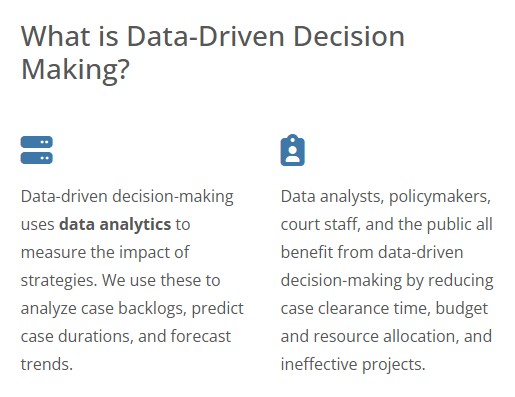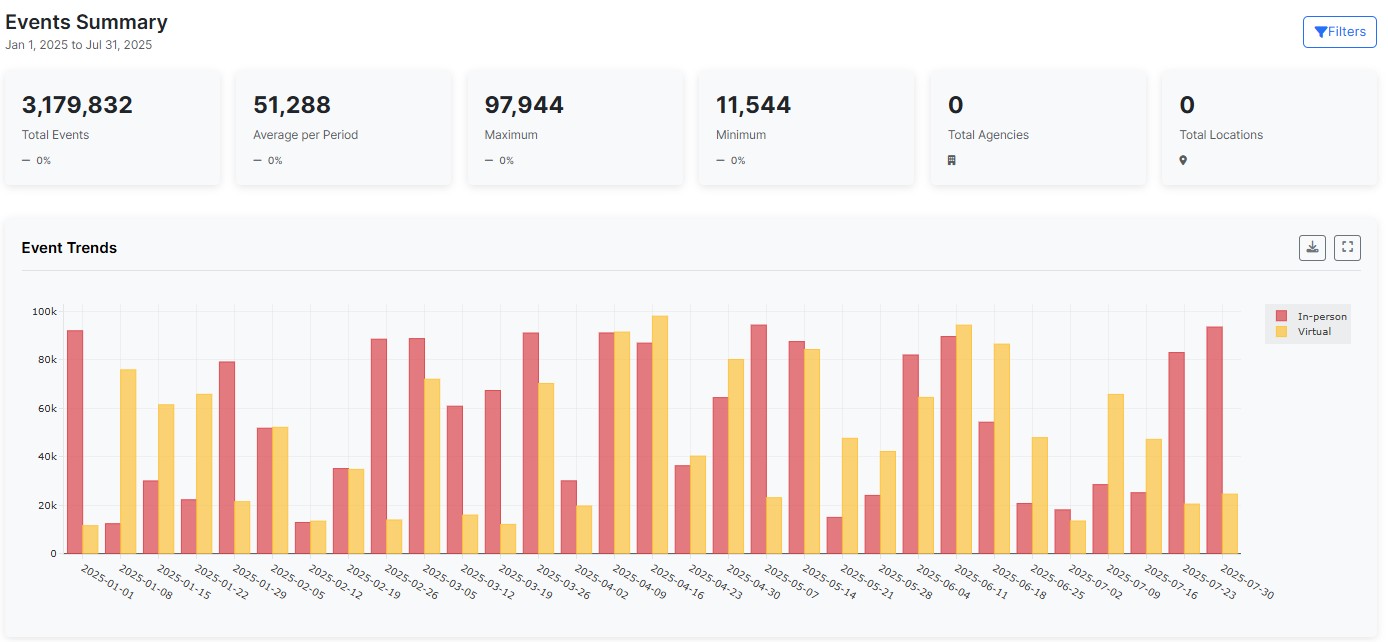Introduction
Across the country, pretrial modernization is gaining momentum as jurisdictions strive to strike a balance between fairness, safety, and efficiency. The Guide to Pretrial Performance Measures from Advancing Pretrial Policy & Research (APPR) offers a clear framework for what to measure, including release rates, failure-to-appear rates, new criminal activity, and supervision outcomes (APPR, n.d.-a).
But identifying what to measure is only half the battle. To truly drive change, measures must be made visible, understandable, and actionable. That is where eCourtDate comes in by transforming static measures into live dashboards that empower stakeholders to connect policy decisions with real-world outcomes.
Why Measurement Matters
The APPR framework emphasizes three objectives of pretrial performance measures: evaluation, accountability, and improvement (APPR, n.d.-a). These objectives are supported by the National Association of Pretrial Services Agencies (NAPSA, 2024), which recommends that jurisdictions establish clear goals and monitor outcomes to ensure that pretrial justice is both practical and fair.
Even just agreeing to measure outcomes is essential. Convincing stakeholders that measurement is valuable is a big win in itself. It indicates a cultural shift from relying on stories to making decisions based on data and evidence.
The Challenge: When Reports Lose Their Meaning
Too often, measures remain hidden in static reports. Quarterly spreadsheets filled with numbers can create three obstacles:
- Delay: results arrive months after the fact, limiting timely action.
- Accessibility: Complex tables can be difficult for policymakers, judges, and community members to interpret.
- Lost momentum: without clear, usable visuals, the initial commitment to measure what matters risks fading.
As Justice Counts, a national initiative led by the Council of State Governments, emphasizes, system metrics only serve their purpose if they are communicated in ways that stakeholders can understand and use (Council of State Governments Justice Center, 2025).
From Measurement to Action: The Role of Dashboards
Dashboards bridge this gap by turning abstract metrics into practical tools. Research has long shown that measures must be accessible and timely to foster real improvement (Clark & Henry, 2003; NIC, 2011).
With a well-designed dashboard, stakeholders can:
- See trends in real time, not just at annual reporting cycles.
- Drill down by risk category, case type, or supervision status.
- Identify differences across categories, helping stakeholders understand how policies perform in practice.
- Connect actions to outcomes, watching in near-real time how policy shifts affect release rates or appearance rates.
Dashboards keep data alive and relevant, ensuring that measures do not just sit on a shelf but actively guide decision-making.
How eCourtDate Makes Measures Usable
At eCourtDate, we help courts and agencies transition from measurement to action by integrating pretrial performance metrics directly into interactive dashboards. Our approach emphasizes:
- Integrating key data streams such as case outcomes, court notifications, and supervision compliance.
- Allowing category-based comparisons so that jurisdictions can see how different practices or conditions influence results.
- Providing drill-down capability for deeper analysis by judge, charge type, or supervision condition.
- Supporting communications interventions like automated court reminders, which research shows can dramatically reduce failures to appear.
For example, a 2025 Pew study found that reminders increased appearance rates in 11 of 12 evaluations, resulting in a reduction of up to 61 percent in missed court dates (Pew Charitable Trusts, 2025). Similarly, research by ideas42 (2025) and Chohlas-Wood et al. (2025) shows that reminders not only boost appearance but also lower warrants and jail admissions related to missed court dates.
With eCourtDate dashboards, agencies can implement these interventions and monitor their impact in real time, closing the loop between policy, practice, and performance. Check out our demo dashboard to see how measures come to life in practice.
Policy Impact of Actionable Dashboards
Dashboards do more than simplify data. They change behavior.
- Judges can see whether release decisions align with appearance and safety outcomes.
- Administrators can identify bottlenecks in processing or supervision.
- Policymakers can evaluate the impact of new statutes or investments.
- Community members can access transparent visuals that build trust.
By making outcomes visible, dashboards ensure that the effort of establishing performance measures truly turns into effective policy.
Conclusion
The Guide to Pretrial Performance Measures explains the "what." Dashboards show the "how." Winning the effort to persuade stakeholders that outcomes matter is a significant achievement. However, the next step is ensuring that those outcomes remain clear, practical, and actionable.
With real-time dashboards, jurisdictions can shift from merely complying to ongoing improvement. At eCourtDate, we are dedicated to transforming measures into meaningful results and meaning into real impact.
References
Advancing Pretrial Policy & Research. (n.d.-a). Guide to pretrial performance measures. https://advancingpretrial.org/improvement-guide/guide-to-pretrial-performance-measures/
Clark, J., & Henry, D. A. (2003). Pretrial services programming at the start of the 21st century: A survey of pretrial services programs. U.S. Department of Justice, Bureau of Justice Assistance. https://www.ojp.gov/pdffiles1/bja/199773.pdf
Council of State Governments Justice Center. (2025). Justice counts: All metrics at a glance. https://justicecounts.csgjusticecenter.org/wp-content/uploads/2025/01/Justice-Counts-All-Metrics-At-A-Glance-508-Accessible.pdf
National Association of Pretrial Services Agencies. (2024). NAPSA standards for pretrial release (revised). https://www.napsa.org/assets/NAPSA%20Standards%20NAPSA%202024.pdf
National Institute of Corrections. (2011). Measuring what matters: Outcome and performance measures for the pretrial services field. U.S. Department of Justice. https://s3.amazonaws.com/static.nicic.gov/Library/033331.pdf
Pew Charitable Trusts. (2025, May 12). States underuse court date reminders. https://www.pew.org/en/research-and-analysis/issue-briefs/2025/05/states-underuse-court-date-reminders
ideas42. (2025, May). The essential guide to court reminder programs. https://www.ideas42.org/wp-content/uploads/2025/05/i42-1530_RemindersRpt_Final.pdf
Chohlas-Wood, A., et al. (2025). Automated reminders reduce incarceration for missed court dates (Preprint). https://5harad.com/papers/court-reminders.pdf

About Greg Shugart
Director of Government Relations
Greg Shugart brings over 30 years of public sector experience to the eCourtDate team, with a background in court administration, criminal justice reform, and government operations. He previously served as Criminal Courts Administrator for Tarrant County, Texas, where he led statewide-recognized initiatives in pretrial modernization, court communications, and system efficiency. Greg now contributes to eCourtDate’s strategy and partnerships, helping agencies implement technology that improves access, compliance, and trust in the justice system.

